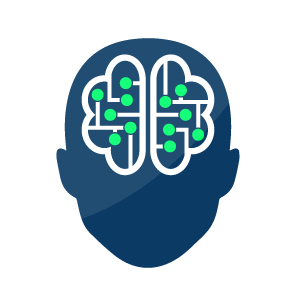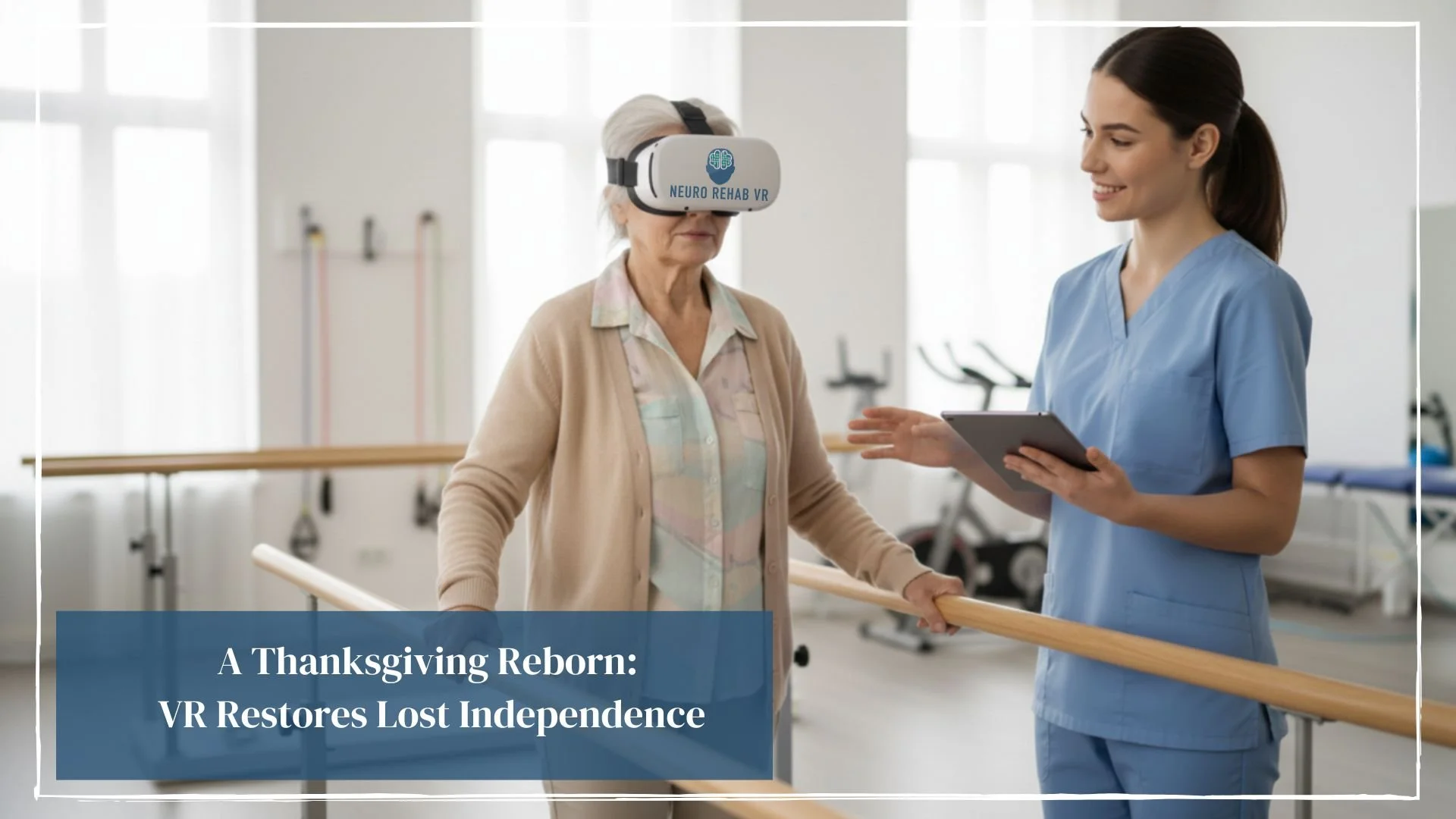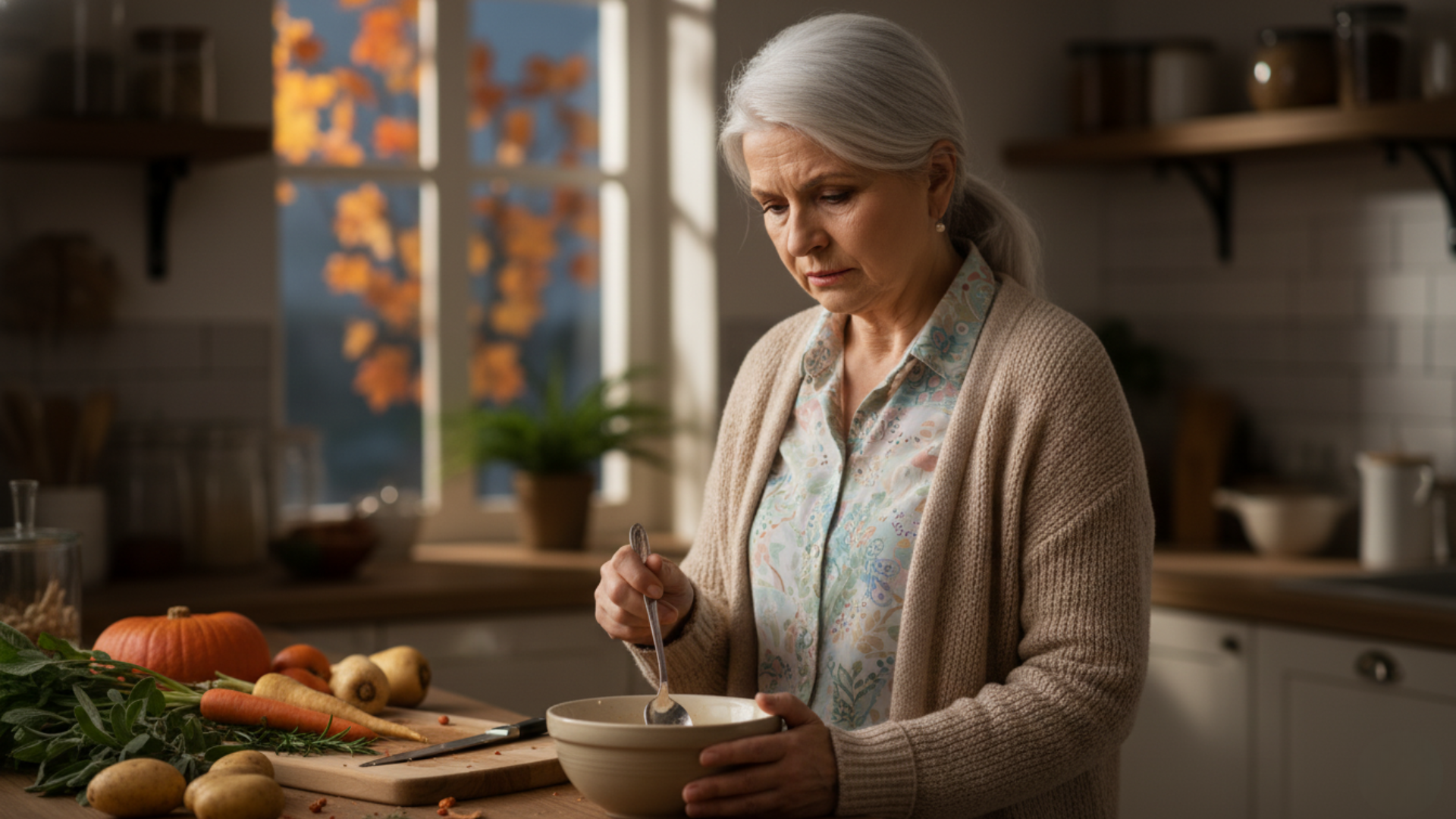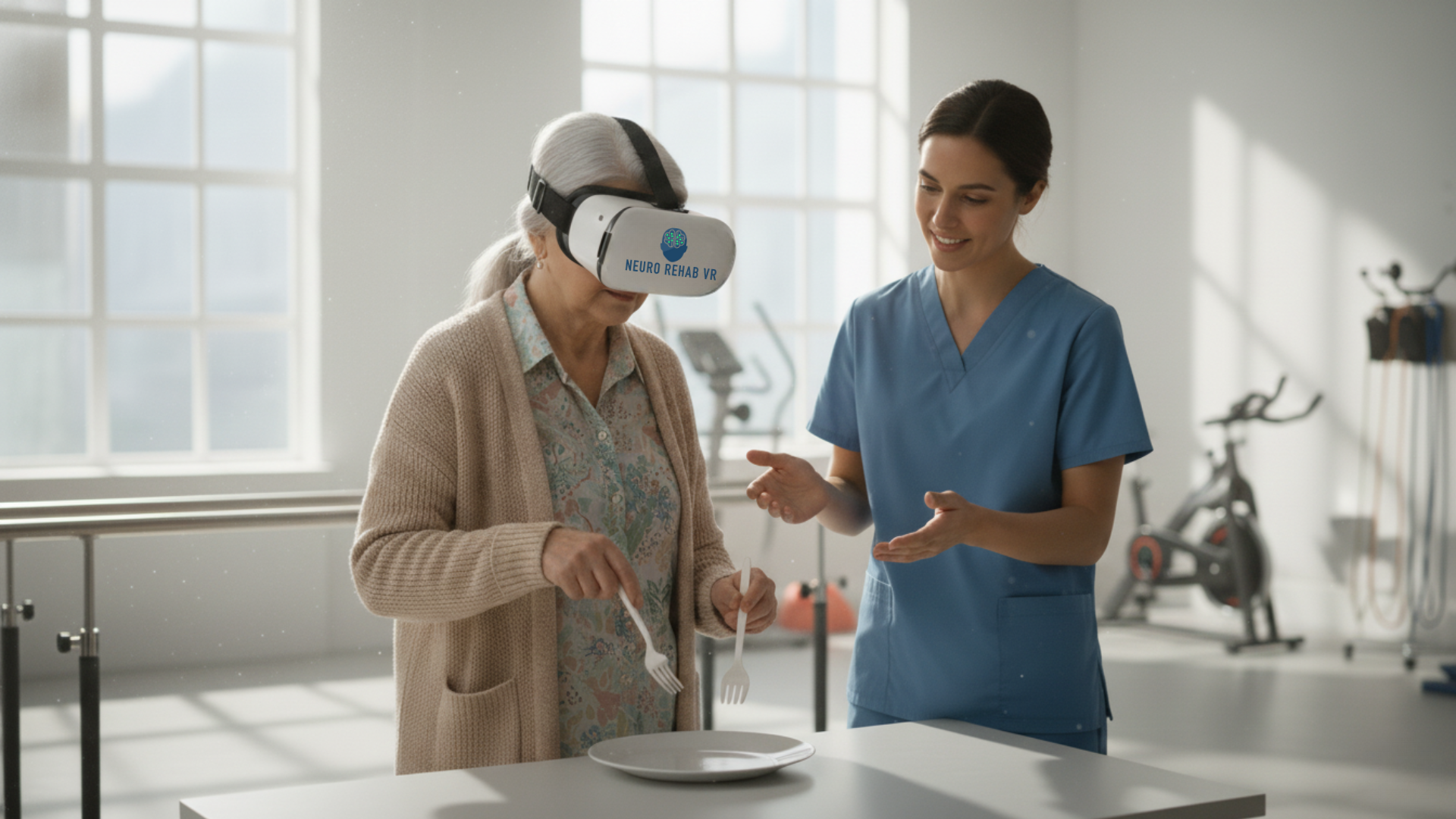A Thanksgiving Reborn: VR Restores Lost Independence
Written by: Brianna Hodge
If you’ve ever watched someone try to return to daily life task after a stroke or neurological injury, you know that recovery isn’t defined by the number of steps they can take or how many exercises they complete in a clinic. It’s defined by the moments that happen at home, moments where identity, confidence, and independence are put to the test.
You see it when a patient stands in front of their stove for the first time since their injury, unsure if their hand will cooperate or if they will be able to even stir the bowl of ingredients.
“I used to do this every day… now I’m scared.”
These moments show just how deeply daily living skills, like cooking, cleaning, planning, and moving around the home, are connected to who we are. And nowhere is this more apparent than during the holidays.
Thanksgiving is not simply a meal. It is memory, tradition, culture, and love wrapped into one day. For many families, the person preparing the food is the emotional center of the holiday. When illness takes that role away, it can feel like losing a part of yourself.
This is why the heart of rehabilitation should always come back to restoring meaningful independence. And today, virtual reality is helping patients reclaim these abilities in powerful, evidence-based, emotionally significant ways.
Rowan-Cabarrus Community College
VR Works Because It Makes Therapy Feel Purposeful Again
One of the most insightful pieces of research on this subject, “Patient-centered insights into virtual reality rehabilitation for stroke: a systematic review and qualitative meta-synthesis,” captures something truly important: patients want therapy that feels meaningful. Across the studies analyzed, patients described VR rehabilitation as engaging, immersive, and giving them hope. They weren’t simply performing random tasks, they were completing activities that reminded them of real accomplishments.
Many patients in the review expressed that VR made them feel safe to try movements that scared them in the real world. One participant noted that VR helped them focus on the task instead of their fear of failing. Another described how VR encouraged them to push themselves further without feeling overwhelmed. These patient voices show that VR is not only a therapeutic tool, it is an emotional anchor that reconnects patients with the sense of “I can do this again.” (Ding et al.)
Cooking tasks in VR, for instance, aren’t symbolic. They mirror real-life challenges. VR gives patients a structured environment where they can practice stirring, grabbing, reaching, and sequencing complex steps without the pressure of making a mistake that ruins a meal or wastes ingredients. The safety and neutrality of the virtual kitchen makes room for confidence to grow.
The Emotional Importance of Cooking During Recovery
Cooking is one of the most meaningful and multidimensional activities of daily living. It requires coordination, attention, planning, memory, balance, and fine motor control, skills often disrupted after a stroke or brain injury. But cooking is also personal. It carries memories of family gatherings, holiday rituals, and identity.
That’s why, for many patients, returning to the kitchen represents something deeper than physical recovery. It represents reclaiming who they are.
Research supports the significance of cooking as a cognitive and motor assessment tool. In the study “A Virtual Versus an Augmented Reality Cooking Task Based-Tools: A Behavioral and Physiological Study on the Assessment of Executive Functions,” researchers explored how participants performed cooking-based tasks in VR and AR environments. They found that cooking tasks in VR activated executive functions such as planning, working memory, task switching, and problem-solving. Participants treated the tasks seriously, demonstrating real cognitive effort, measurable engagement, and physiological responses similar to real-world cooking.(Chicchi Giglioli et al.)
This means that when a patient practices a cooking task in VR, they are strengthening the same brain systems required to cook in real life. The virtual environment becomes a bridge, a safe place to challenge their mind and body without the risk of sharp knives, hot pans, or spills. And for patients who feel emotionally fragile after losing abilities they once took for granted, that psychological safety matters just as much as the physical practice.
VR Can help encourage patients
One of the most surprising findings in modern rehabilitation research comes from Transfr’s study “Culinary Skills VR Learning Gains Beat Real-World Practice.” This study revealed that learners who practiced culinary skills inside VR often improved faster and retained their skills better than those who trained in a traditional kitchen. (Transfr)
This effect occurs because VR removes many of the barriers that slow down or discourage early learning. Mistakes can be reset instantly. Steps can be repeated without needing to gather materials again. Attention is naturally focused on the task because distractions are minimized. And because VR provides structured guidance, patients build muscle memory and sequencing abilities without feeling overwhelmed.
For stroke survivors relearning motor skills, this structured repetition is crucial. Stirring, grasping utensils, pouring, reaching across counters, holding bowls, and sequencing steps all become part of a predictable cognitive model. VR ensures the patient gets the practice they need, while the therapist ensures the practice is meaningful.
When Thanksgiving comes around, and a patient finally feels confident enough to chop vegetables or prepare a dish again, even with adaptations, it is a big milestone for them.
The Clinical Evidence: VR Strengthens Motor Function After Stroke
The emotional side of cooking recovery is powerful, but the motor side is equally important. When a patient stirs a pot or lifts a baking sheet, they are activating complex muscle groups. Strengthening these skills requires practice, repetition, and engagement, the three pillars of effective stroke rehabilitation.
In the large-scale review “The efficacy of virtual reality-based rehabilitation in improving motor function in patients with stroke: a systematic review and meta-analysis,” researchers found that VR-based therapy significantly improved upper-limb motor function compared to conventional therapy alone. Patients who used VR demonstrated better grip strength, more refined hand coordination, smoother arm movements, and greater overall motor recovery. (Priyadarshi Prajjwal et al.)
What made VR successful in these studies was not just the technology itself but the motivation it created. Patients consistently engaged longer and showed higher adherence when using VR because the tasks felt purposeful and immersive. When patients enjoy therapy, they do more of it, and more therapy leads to better outcomes.
This is one of the reasons VR-based cooking tasks are so effective. Cooking naturally engages fine motor skills, bilateral coordination, and controlled reach patterns. When practiced in VR, these movements are repeated often enough to stimulate neuroplasticity while avoiding the fatigue or discouragement patients may feel in a real-world kitchen.
How VR Integrates Motor, Cognitive, and Emotional Rehabilitation
The research synthesis presented in “Virtual and Augmented Reality in Post-stroke Rehabilitation: A Narrative Review” offers a comprehensive view of why VR is so transformative for daily living skills training. The review highlights how VR simultaneously supports motor function, cognitive performance, attention, balance, and emotional readiness, all within a single therapeutic environment.
One of the most compelling points discussed is how VR reduces patient anxiety. Many individuals recovering from stroke are afraid of making mistakes when performing real-life tasks, especially ones involving heat, height, or precision. VR allows them to attempt complex activities, like carrying a bowl across a kitchen, pouring liquids, or moving food from counter to stove, without fear of injury. As their confidence grows in VR, that confidence transfers back to real life. (Rhutuja Khokale et al.)
The narrative review also emphasizes VR’s ability to promote neuroplasticity through repetitive, goal-directed movements. This is especially important when teaching tasks that have cultural or emotional significance. For someone who wants to prepare Thanksgiving dinner again, each virtual simulation brings them one step closer to reclaiming that part of their identity.
A Patient’s First Thanksgiving Back in the Kitchen
Therapists often share stories of patients experiencing breakthrough moments in VR. One composite case stands out, a woman named Evelyn, age 71, who had a stroke that left her right arm weak and her confidence almost nonexistent. For 40 years, she had hosted Thanksgiving and made the same cornbread stuffing her mother once made. After her stroke, she felt that tradition slipping away.
The first time she walked into her real kitchen after her injury, her hand trembled as she touched a spoon. She said the silence in the room made her feel small. She stared at her mixing bowl, unable to lift it, and quietly whispered, “I can’t do this anymore.”
But when her therapist introduced VR, something shifted. In the virtual kitchen, she could practice reaching, mixing, lifting, sequencing, and standing tolerance without worrying about spilling, burning herself, or disappointing anyone. When her hand shook, nothing broke. She could reset the task and try again without shame.
Over time, Evelyn’s brain began reconnecting the motions of cooking with the feeling of success.
Her movements became smoother, endurance improved, and smile returned.
After several weeks, she was able to prepare her cornbread stuffing again, slowly and with adaptations, but independently. VR didn’t just improve her motor function, it also restored her identity.
How Neuro Rehab VR Brings These Research Findings to Life
The Smart Therapy™ Complete Solution by Neuro Rehab VR was built with exactly these kinds of patient stories in mind. It gives therapists clinically grounded tools to help patients practice meaningful daily living activities, especially cooking-related tasks, within a safe and controlled environment.
The system includes immersive therapy sessions where patients can simulate real-world environments that require coordination, balance, planning, and fine motor precision. Instead of performing exercises that feel disconnected from their goals, patients can engage in virtual tasks like preparing meals, following multi-step sequences, and carrying objects from place to place.
These activities naturally weave motor and cognitive demands together.
Stirring requires grip strength and rotational control.
Reaching for ingredients requires balance and weight-shifting.
Following a recipe requires sequencing and working memory.
Carrying items builds confidence and spatial awareness.
Neuro Rehab VR also supports the therapist through AI-driven features such as automated SOAP notes and detailed kinematic tracking. This means clinicians can focus on patient interaction rather than documentation, while still collecting rich movement data that guides treatment progression.
Across hospitals, SNFs, outpatient clinics, VAs, and academic programs, therapists use this solution to help patients regain not just their physical abilities but their sense of purpose.
Thanksgiving Tasks VR Helps Patients Rediscover
As we think about the Thanksgiving advert, showing a grandmother struggling in her kitchen until virtual therapy helps her regain confidence, the message becomes clear: holidays aren’t just events; they are emotional milestones.
In therapy rooms across the country, VR is helping patients relearn the very tasks that make Thanksgiving meaningful. They practice movements required for folding table linens, organizing ingredients, carrying dishes, and setting a dining table. They work on navigation tasks that mimic grocery shopping, and they rebuild the sequencing skills needed to follow a recipe step by step. Even tasks like standing for longer periods during meal prep become part of therapy in a way that feels practical, safe, and rewarding.
These aren’t small accomplishments. For someone recovering from stroke or neurological injury, these moments mark a return to themselves.
Conclusion: Independence Is the True Goal of Rehabilitation
At the end of the day, rehabilitation is not just about improving scores or hitting clinical benchmarks. It’s about restoring function in real life. It’s about helping someone regain the confidence to cook their favorite meal, host their family, or simply feel like themselves in their own home.
The research is clear: VR is a powerful tool for improving motor function, enhancing cognitive performance, strengthening executive skills, and increasing patient engagement. But beyond the data, VR offers something more profound, it offers hope.
This Thanksgiving, many patients will stand in their kitchens again because of the work they’ve done in VR. They will chop, stir, reach, and create, it may not be perfectly or quick, but they will gain independence. And for them, that moment means everything.
-
Chicchi Giglioli, Irene Alice, et al. “A Virtual versus an Augmented Reality Cooking Task Based-Tools: A Behavioral and Physiological Study on the Assessment of Executive Functions.” Frontiers in Psychology, vol. 10, 14 Nov. 2019, https://doi.org/10.3389/fpsyg.2019.02529.
Ding, Kun, et al. “Patient-Centered Insights into Virtual Reality Rehabilitation for Stroke: A Systematic Review and Qualitative Meta-Synthesis.” Journal of NeuroEngineering and Rehabilitation, vol. 22, no. 1, 2 June 2025, https://doi.org/10.1186/s12984-025-01641-9.
Priyadarshi Prajjwal, et al. “The Efficacy of Virtual Reality-Based Rehabilitation in Improving Motor Function in Patients with Stroke: A Systematic Review and Meta-Analysis.” Annals of Medicine and Surgery, vol. 86, no. 9, 2 Aug. 2024, https://doi.org/10.1097/ms9.0000000000002403.
Rhutuja Khokale, et al. “Virtual and Augmented Reality in Post-Stroke Rehabilitation: A Narrative Review.” Virtual and Augmented Reality in Post-Stroke Rehabilitation: A Narrative Review, vol. 15, no. 4, 14 Apr. 2023, www.ncbi.nlm.nih.gov/pmc/articles/PMC10183111/, https://doi.org/10.7759/cureus.37559.
Transfr. Learning Culinary Skills in vr Beats Real-World Practice. transfrinc.com/resources/efficacy-studies/culinary-skills-vr-learning-gains-beat-real-world-practice/.





